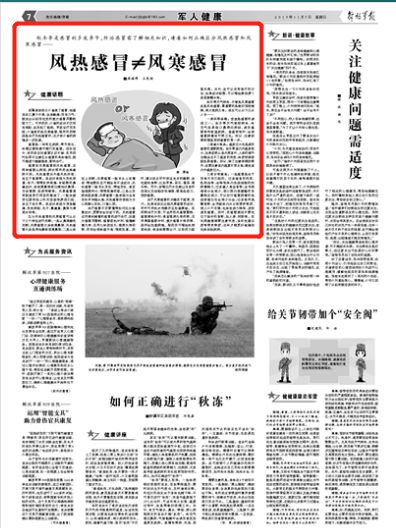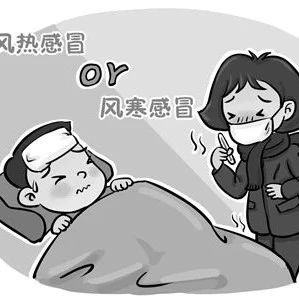Autumn and winter are peak seasons for colds. To prevent and treat colds effectively, it is essential to understand the relevant knowledge. Here’s how to correctly distinguish between Wind-Heat and Wind-Cold colds—
Wind-Heat Cold ≠ Wind-Cold Cold
■ Zhou Ruibo, Wang Huijuan
Soldier Xiao Cui from a certain unit of the armed police caught a cold. He felt nasal congestion, body aches, and fatigue, so he took some leftover Fang Feng Gan Mao Ling (Compound Cold Remedy) granules.However, after taking the medication, Xiao Cui’s symptoms not only did not improve but he also developed a high fever.After examination by military doctors, it was found that Xiao Cui had a Wind-Cold cold, but the medication he took was for treating Wind-Heat colds, which worsened his condition.Colds are a common illness, often triggered by seasonal changes and temperature fluctuations.However, some comrades do not have a sufficient understanding of colds, and if they do not pay attention to distinguishing the specific situation of the cold when taking medication, it may lead to health risks and affect treatment.Colds can be classified into Wind-Cold and Wind-Heat colds, which differ significantly in terms of causes, symptoms, and medication choices.Wind-Heat colds are caused by external Wind-Heat, commonly seen in spring and summer.The symptoms include higher fever, sweating, sore and swollen throat, mild nasal congestion, and a tendency to produce yellow or thick nasal discharge, with a yellow and thick tongue coating, and a tendency to cough.Wind-Cold colds, commonly referred to as catching a chill, are generally caused by excessive fatigue combined with exposure to wind and cold, often seen in autumn and winter.The symptoms include body aches, mild fever, no sweating, severe nasal congestion, and clear or watery nasal discharge.To distinguish between Wind-Heat and Wind-Cold colds, one can judge based on the following three characteristics:First, by the color of nasal discharge: Wind-Cold colds mostly produce clear nasal discharge, while Wind-Heat colds typically produce turbid or yellow nasal discharge;Second, by physical signs: Wind-Cold colds generally present with a thin tongue coating, slightly red throat, and possible discomfort, while Wind-Heat colds usually show a red tongue, red throat, and possibly swollen tonsils with significant throat pain;Third, by the manifestation of symptoms: Wind-Cold colds typically present with a feeling of cold throughout the body accompanied by headaches, while Wind-Heat colds present with hot palms and soles, thirst, and irritability.

△ Illustration by Jiang Chen
Treating a cold requires not only understanding how to distinguish cold symptoms but also knowing how to treat them accordingly.For Wind-Heat colds, medications that clear heat and detoxify should be used, such as Fang Feng Gan Mao Ling (Compound Cold Remedy), Gan Mao Tui Re Chong Ji (Cold and Fever Relief Powder), and Yin Qiao Jie Du Wan (Yin Qiao Detoxifying Pills). Avoid using Jiu Wei Qiang Huo Wan (Nine Flavor Qiang Huo Pills) and Li Fei Wan (Lung Regulating Pills), as they may raise body temperature and worsen throat pain.Additionally, comrades are advised to ensure adequate sleep and consume heat-dispelling foods, such as apples, bitter melon, tomatoes, and cucumbers.Moreover, drinking plenty of boiled water can enhance blood circulation and cellular activity, boost immunity, and prevent colds.The key to treating Wind-Cold colds lies in dispelling cold and inducing sweating.If comrades exhibit symptoms of Wind-Cold colds, they can soak their feet in hot water and cover themselves with thick blankets.In terms of medication, options include Shang Feng Gan Mao Granules (Wind Cold Cold Granules), Gan Mao Qing Re Chong Ji (Cold and Fever Relief Powder), and Tong Xuan Li Fei Wan (Open and Regulate Lung Pills). Avoid using Sang Ju Gan Mao Chong Ji (Mulberry and Chrysanthemum Cold Powder) and Fang Feng Gan Mao Pian (Compound Cold Tablets), as misuse may worsen the condition.After taking medication, drinking some hot porridge or soup can help induce slight sweating to assist the medication in dispelling Wind-Cold.Additionally, dietary therapy can be employed; if symptoms are mild, one can drink ginger and radish soup or ginger syrup.As the weather turns cold in autumn and winter, whether it is a Wind-Cold or Wind-Heat cold, the most important thing is to take preventive measures to reduce the likelihood of illness.Comrades can start with the following points—First, keep warm and prevent cold.Exposure to cold is one of the triggers for colds.As the weather gradually turns cold in autumn and winter, cold air can easily invade the lungs through the mouth and nose, triggering colds and other respiratory diseases.When the indoor temperature is low, it provides an opportunity for cold viruses to thrive.Therefore, paying attention to warmth and cold prevention is the first step in preventing colds.Second, minimize temperature differences.Excessive temperature differences are also a significant cause of colds.In autumn and winter, the temperature difference between indoors and outdoors increases. If one suddenly moves from indoors to outdoors, the body’s regulatory functions may not adapt to the sudden temperature change, making those with weaker constitutions more susceptible to colds.Thus, in addition to keeping warm, one should also ensure that indoor temperatures are not too high to avoid excessive temperature differences between indoors and outdoors.Third, maintain a balanced diet.Some colds are caused by improper diet.Excessive consumption of meat and dairy products can reduce the antiviral capacity of immune cells in the body;excessive intake of high-salt foods can reduce saliva secretion, thereby decreasing the amount of lysozyme in the oral cavity, which can combat cold viruses, and the secretion of immunoglobulins that fight colds will also decrease;excessive consumption of high-sugar foods can deplete the body’s moisture and nutrients, leading to dry mouth and decreased immunity, which can trigger colds.Additionally, during a cold, one should avoid overly nourishing foods, such as ginseng and donkey-hide gelatin.During the recovery period, it is essential to rest and replenish nutrients such as protein to better assist the body in overcoming the illness.

This article was published on November 3, 2019, in the PLA Daily
“Military Health” section
 Published by Military Reporters on WeChat
Published by Military Reporters on WeChat
Compiled by: Wu Liangchao;
Edited by: He Min, Sun Weishuai;
Reviewed by: Zhang Huajing;
Submission email: [email protected];
Please indicate the source when reprinting

